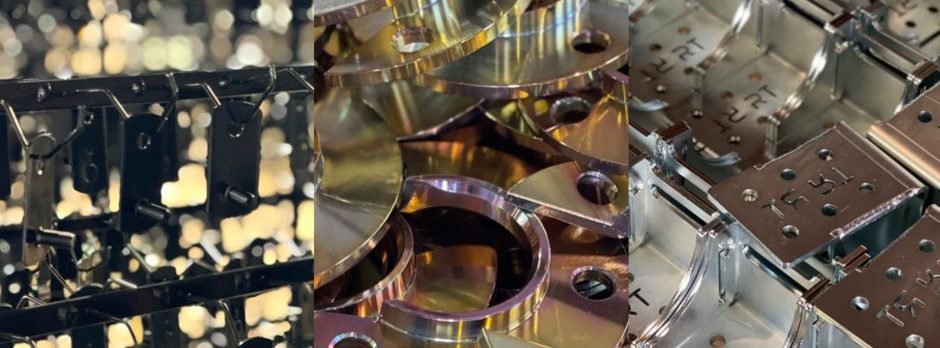What is Hydrogen Embrittlement and why do I want to relieve it?
Hydrogen Embrittlement (HE) refers to the increased internal stresses caused by hydrogen within the grain structure of ferrous articles. HE is not exclusive to electroplating let alone zinc electroplating, but can be caused by several different metal finishing and related processes. Under AS 1789-2003 Electroplated zinc (electrogalvanized) coatings on ferrous articles (batch process), heat treatment pre/post-plating is specified for steels with a maximum tensile of 1000+ MPa. The heat treatment processes are similar to general stress relief heat treatment processes for steels, but the focus is on allowing hydrogen time to escape from below the zinc plating layer.
If you have what is referred to as a ‘high’ tensile steel (1000+ MPa), it is accepted that the effects of HE will be more critical. The effects are basically premature brittle failure of high tensile steel. Given your design calls for a high tensile steel, then it is also assumed that the tensile is critical for the design otherwise any grade of mild steel would have sufficed? AS 1789 also relates HE to hardness (including surfaced hardened parts) if tensile is not easily obtainable. The harder the part, the higher the tensile. Roughly speaking 1000+ MPa in steels relates to HRC 34, or 340 HV, or 325 HB. Remember that most hardness measurements can be compared across types i.e. 352 HB = 69.3 HRA = 110.0 HRB = 37.9 HRC = 53.8 HRD = 372 HV = 51 HS.
Not all its cracked up to be!
So Hydrogen Embrittlement Relief (HER) is important and you want your electroplater to go ahead and sort out the heat treatment for you… … … …this is the bit where you tell the electroplater for how long and at what temperature! If you’re lucky you will have a full copy of a standard for which your part is to be zinc electroplated to, including the heat treatment specification. Otherwise its back to basics and this is a very good time to think about what you’re trying to achieve by having this part zinc electroplated.
Firstly, lets look at some alternatives to heat treatment
Eliminating the critical stress point(s) is normally good design practice in itself as sharp bends/corners and edges give rise to stress related cracking especially in thin sheet metal. Components made from spring steel by nature are not meant to be ductile and normally undergo a hardening and tempering process prior to plating to give the formed steel its ‘spring’. Increasing the radius in bends and increasing material thickness can eliminate the requirement for HER. Sharp tooling reduces stress by cutting the material and not tearing it apart. Aggressive forming techniques increase stresses in materials, especially from cold worked material, in fast heavy presses, with unsupported dies. Polishing, peening, filing and other forms of smothing a surface with an abrasive material have limited effects in the case of HE, as they can increase surface hardness.
Substitution of tensile strength is a common practice to avoid heat treatment issues in fasteners. By dropping down to a Class 4.6 bolt HE is not a significant issue. This may simply require an increase in bolt diameter, or the total number of bolts in a pattern to match the tensile and shear requirements provided by the high tensile bolt. Obviously this method can also be applied to other steel applications where a change in tensile is possible.
Reduce the hardness of the material to be plated. Not so easy if the part is designed for wear, but if the hardness comes from working, forming, or welding the material, can this be reduced?
So you’re stuck with heat treatment.
Why are you stuck with heat treatment, how do you actually know you need to eliminate hydrogen embrittlement? Did your electroplater or galvanizers tell you? Obviously not your design department or customer, because they would specify another metal finish or give you the heat treatment details?
Disclaimer: Please take the following on ‘advice only’ when considering Hydrogen Embrittlement Relief because every customer’s product is different and the final decision of pass/fail is with the customer, not the electroplater!!!! If you’re only reference for establishing heat treatment requirements is reading websites you need to consider a career change, its dangerous and this is only meant as an introduction to the topic.
Failures and testing says you have a HE issue. You no longer have a HE issue when your testing stops giving you failures.
Testing for HE failure is usually done insitu, hence the article is placed into a similar service condition under the required forces. A bolt would be threaded onto a nut/fixture and tested under tensile and shear forces for premature failure. If all test samples left in a loaded stated for 24 hours do not crack then it might be demed that the HER oven time & temperature were adequate. It might also be possible to scale back some of these parameters to improve efficience and cost-effectiveness of the process. A spring clip might be left forced open to its operating gap for 24 hours. Any clips that have failed after 24 hours might deem as requiring a longer HER time in the oven.
As for the sample size you will need to go back to ‘statistics 101’ and justify your sample size to meet you six standard deviation, or 3.4 parts per billion failure rate. Whatever helps you sleep at night or keeps your customer happy. There are a few sources of reference for Hydrogen Embrittlement and I would encourage those concerned take the time to check the latest information available from recognised published sources.
